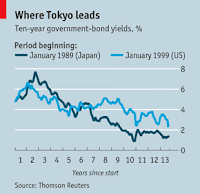Idéias de um livre pensador sem medo da polêmica ou da patrulha dos "politicamente corretos".
sexta-feira, setembro 02, 2011
Buttonwood: The lowdown
The Economist
BOND-MARKET vigilantes have a ferocious reputation but it turns out they can be very forgiving. Although Standard & Poor’s has downgraded America’s credit rating and the 2011 budget deficit is expected to be 9% of GDP, the Treasury can still borrow at a remarkably cheap rate. On August 31st all Treasury bonds maturing within five years were yielding less than 1%.
Short-term bond yields are driven by expectations about the outlook for official interest rates. The Federal Reserve has committed itself to keeping rates at their current ultra-low level (between zero and 0.25%) for the next two years. In turn, such low rates also drag down bond yields at longer maturities.
It all looks very Japanese. As the chart shows, since 1999 ten-year Treasury-bond yields have followed a remarkably similar path to that taken by Japanese bond yields after that country’s economic bubble burst in 1990. The big question is whether they will now stabilise, as Japanese yields did, in the 1-2% range.
Much will depend on the outlook for inflation. Japan had a brief period of deflation in the mid-1990s, followed by a more consistent pattern of flattish prices over the past decade. Real yields have thus been positive for much of the period.
In contrast, the brief burst of American deflation in 2009 was followed by a strong rebound in prices. Headline inflation is running at 3.6%, making real yields markedly negative. (The same is true for real yields on inflation-linked bonds.) That makes bonds look a pretty unattractive option unless investors believe deflation is on its way.
According to the Barclays US bond index, the last time that nominal yields were around today’s level was in 1949 and 1950. Investors who bought bonds back then saw the real value of their holdings halved by the late 1960s. But strategists at Société Générale estimate that the fair value for ten-year Treasury bonds (based on growth and inflation rates over the previous ten years) is just 2.75%, not a long way above current levels. Bonds looked far more overvalued, on this model, in 2002 and 2008.
The bond market is a rather better forecaster of recessions than the average economist. There has been a sharp fall in bond yields even though the Fed’s programme of quantitative easing (creating money to buy bonds) stopped at the end of June, taking a large source of demand out of the market. That is a clear sign that investors are worried about economic growth.
It is true that one big recessionary signal has not appeared—the inversion of the yield curve (meaning that long-term yields fall below short-term rates). But it is impossible to generate such a signal at the moment thanks to the Fed’s policy of near-zero short rates. And that policy is itself a sign that the central bank is extremely concerned about the economic outlook.
Once the debt crisis broke in 2007, it was clear there were four ways that the mess could develop. The best hope was for economies to grow their way out of the problem. But the recovery has been so anaemic that output in the world’s largest developed economies is still below its 2008 levels.
The second route was to inflate the debt away. Headline inflation rates have risen thanks to commodity prices. But there has been no sign yet that the authorities are able to generate a 1970s-style wage-price spiral, even assuming that they want to. There may be some scope for “financial repression”, whereby investors are channelled towards government bonds and real yields are held at negative rates for an extended period, but this is a very slow way of reducing debt.
The third path was outright default. That may be on the cards for Greece but, barring political miscalculation, the chances of it are remote for countries, like America and Britain, which can issue debt in their own currencies.
The fourth possibility was stagnation, which takes us back to the Japanese example. Plenty of investors and commentators have lost money (or face) during the past decade by predicting that Japanese bond yields would rise sharply. But even though Japan’s debt-to-GDP ratio is far higher than those of America and much of Europe, there is no sign yet of imminent collapse.
Japanese investors have proved happy to hold bonds, given that the alternatives have been the country’s moribund equity and property markets. Its example shows why low bond yields are not good news at all for equity and property markets in America and Europe. Instead they are a dreadful omen.
Assinar:
Postar comentários (Atom)


Nenhum comentário:
Postar um comentário